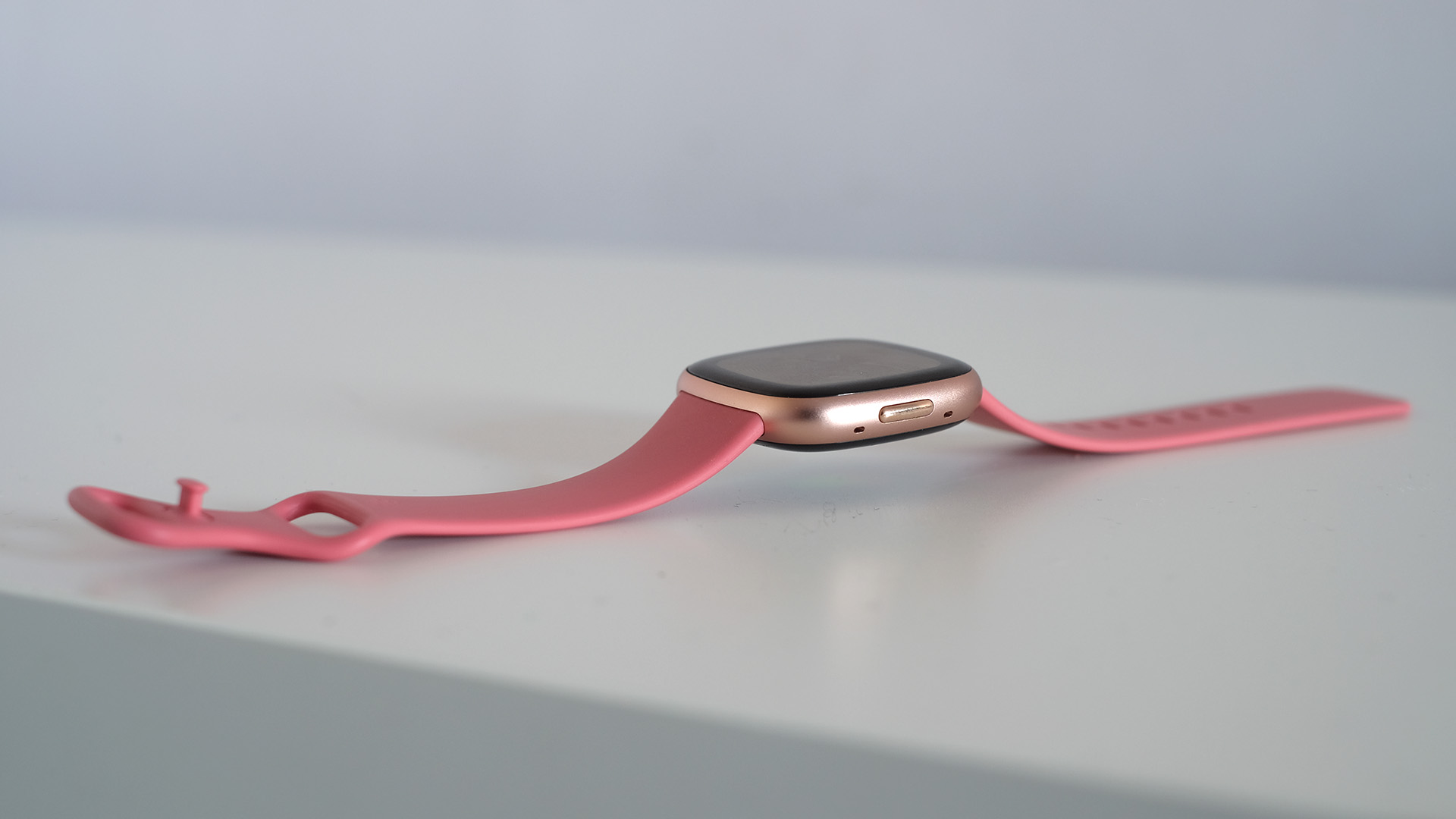Live Science Verdict
The Fitbit Versa 4 is a likable casual fitness tracker watch with some smart, but some cut, features. So-so stat chops mean it is not as competitive as the older models were.
Pros
- +
Multi-day battery life
- +
Nicely animated interface
- +
A more distinctive design than most
Cons
- -
Issues with HR and altimeter accuracy
- -
GPS can be very slow to triangulate
- -
No music or third party apps
Why you can trust Live Science
The Fitbit Versa 4 is a fairly affordable alternative to an Apple Watch, and a cut-down take on the Fitbit Sense 2. You may lose the Sense 2’s advanced EDA stress sensor and the ECG heart health tech, but for everyday fitness tracking and surface-level smartwatch charm, the Versa 4 is every bit a match for the pricier Sense 2.
Compatibility: iOS and Android
Screen size: 40.4 x 40.4 x 12.3mm
GPS: Yes
Battery life: Around six days
Altimeter: Yes
Water resistance: 5ATM
This is a watch that lasts a little under a week of light use, for less upkeep than the average smartwatch. However, you do need to manage your smart feature expectations before buying. Its smarts are fairly shallow.
You can’t use it to play music, which is a big feature hole in a watch like this, and it does not support third-party apps (older high-end Fitbit watches did). A Versa 4 is a good buy for those who like the style but the trajectory for the best Fitbit watches raises some eyebrows.
Price and release date
The Fitbit Versa 4 launched in September 2022 alongside the Fitbit Sense 2. This was two years after the Fitbit Versa 3, and the biggest gap we’ve seen between Versa watches to date. Before the Versa 4 they turned up annually.
You’ll pay $229/£199 for a Versa 4, making it $70/£70 less than the Fitbit Sense 2. If you’re already keen on the idea of owning a Fitbit, one of the things to decide is whether its extra features are worth that money. We’ll hopefully answer that in this review.
Design and display

The Fitbit Versa 4 looks and feels very similar to the Fitbit Versa 3. You get the same slightly bulbous but attractive face with curved aluminum sides and 2.5D display glass.
While the screen bezel is much larger than the Apple Watch Series 8’s, Fitbit watches have a character of their own. And that is impressive enough when we’re dealing with a fairly plain, sensible design.
Get the world’s most fascinating discoveries delivered straight to your inbox.
The side button is the one obvious positive design change of the Fitbit Versa 4. Fitbit’s last-generation watch used a touch panel. This ended up being irritating, as touch controls often are. A classic clicky button is an improvement.
The screen is just like the Versa 3’s; a 1.58-inch 336 x 336 pixel OLED panel. It’s noticeably less sharp than the smaller 360 x 360 pixel screen of the Garmin Venu Sq 2, but that only exhibits as a slight fuzziness to text when you look close, and it’s bright and clear outdoors.
At around 40g with a strap, the Versa 4 is light enough for 24/7 wear, and there’s no need to take it off in the shower or swimming pool. It is water resistant to 5ATM/50M, which is good enough to let you rinse the watch under a tap.
Fitbit does not recommend you wear it in the “hot tub or sauna”, though — one to bear in mind if your gym is a bit more upscale than most.
Features

The Fitbit Versa 4 has a fairly broad range of features, without offering all that much depth compared to some rivals. One thing to take on board is this is not really a smartwatch. You can’t download extra apps, and some of the more advanced features will only work when connected to your phone over Bluetooth.
Let’s start with what it can do, though. The Fitbit Versa 4 lets you set alarms and timers, check the weather and receive notifications from any app on your phone. Upping the ante beyond the basics, it supports wireless payments using the Fitbit Pay platform and, we are told, support for Google Play is coming in future too.
You can also talk to Amazon Alexa through a Versa 4, by long-pressing the side button. This works fairly well, but if your phone isn’t nearby, and connected over Bluetooth, Alexa won’t work.
Alexa replies are played through the watch’s own speaker. It’s a fairly terrible speaker, big on distortion despite being not-so-big on volume, but that audio feedback is an important part of the digital assistant experience.

The Versa 4 also has a basic guided breathing mode, but it’s hardly Headspace on your wrist. Fitbit does offer far more in-depth mindfulness exercises, but as part of its $9.99/£9.99 a month Fitbit Premium subscription. Fitbit Premium is a little like Apple’s Fitness+. It includes video workouts, guided meditations and nutrition plans (available on the phone, not the watch), but it also puts some important Versa 4 stats behind a paywall.
These are long-term trends in metrics like resting heart rate, heart rate variability, breathing rate and oxygen saturation. While you can see recent stats for these in the Fitbit app on your phone, over the previous week, Premium introduces a 30-day history and what it calls ‘personal ranges’, establishing your ‘normal’ baseline.
This paywall stings a bit, making it seem like your Versa 4 is slightly hobbled, nudging you rather aggressively towards a Premium sub.
The Fitbit Versa 4 balances out some of this potential ill will by including a 6-month taster subscription and being generally pleasant to use. Its software is packed with bubbly animations for when you reach your step goal, the interface is fairly easy to understand, and it has a nice amount of color.
The watch also has 40 activity modes — a very conspicuous increase over the 20 of the Versa 3. However, lots of these feel generic. ‘Bootcamp’ just records the duration, your heart rate and a vague estimation of calories, just like Indoor Climbing, Yoga, Spinning, Aerobics, Weightlifting and others.
Maybe the calorie-generating algorithm is a little different in each, but there’s not much substance to these modes.
There are, thankfully, a couple of neat exceptions. HIIT and Interval Training let you customize the structure and time of your efforts. We’d like to see this kind of structure in the running mode too — Garmin and Apple offer such workout customisation in watches at this level.
Performance

The Fitbit Versa 4 is not as effective a fitness tracker as an Apple Watch or Garmin’s closest rival, the Venu Sq Music 2, but we still think it’s largely fine for casual exercise tracking.
On the heart rate side, the Versa 4 always tends to overshoot on exertion spikes. The reading goes too high for a short period, before coming back down as the heart rate algorithm realizes it made a boo-boo.
Much bigger heart rate spikes, clear aberrations that last a few seconds, happened a couple of times during the fistful of workouts we tried too.
This sounds bad, but the Versa 4 is not a HR disaster. Maximum and average heart rate figures are still closely aligned with those of the Fenix 7 and Apple Watch Series 8 when we wore two wearables on a single workout.

GPS has caused a few headaches, though. While the tracking accuracy and signal solidity seem fine, the Versa 4 can take its time to triangulate.
As with any wearable, this speeds up if you consistently track runs or walk in the same location. But after leaving the Versa 4 off for a few days, we returned only to see it take several minutes to connect to GPS. To make matters worse, the watch did a bad job of estimating the distance using motion sensors while the GPS signal was AWOL.
The watch’s current software also seems to have some real issues with altimeter calibration. This hardware is used to count how many flights of stairs you climb each day. On one day, the Versa 4 pegged us at 30 floors, which is at least three times over the real figure.
Daily step counts are much more reasonable, though, and Fitbit takes a sensible route for things like heart rate variability and blood oxygenation. These are measured overnight, when readings are less likely to be disturbed by motion.
Fitness tracking performance is not top-tier, but probably fine for more casual use as long as a firmware update sorts out the altimeter issue. Battery life is in step with this style too. We found it can last an estimated 6.2 days with around 45 minutes to an hour of GPS tracked exercise every other day.
You’ll see this battery life dip significantly to around three days if you use the ‘always on’ screen mode, or perhaps slightly less if you actively use the watch a lot. Even then, the experience is still quite different to the every-day charging of an Apple Watch or Google Pixel Watch.

Verdict
Two years after the Versa 3, Fitbit’s Versa 4 brings us a physical button and a set of features that seems, and is, more stripped-back and restrictive than before. Fitbit’s higher-end wearables are headed in a strange direction.
However, this should not put everyone off, and the dumping of any form of music support is the one major mis-step. A watch doesn’t need an app store to be useful, after all.
The Fitbit Versa 4 is a good casual use fitness tracker, and offers real smartwatch gloss with a much longer battery life than the single day smartwatch norm. Still, there are better options for tracking accuracy and depth.
If this isn’t for you
The step-up Fitbit is the Fitbit Sense 2. It’s a similar watch but has ECG and EDA sensor hardware. That first one analyzes your heat’s sinus rhythm to check for potential signs of an underlying heart issue.
It’s neat, but requires active participation and may often go unused for long periods by some. EDA is all about stress and, again, requires active participation, but the watch in general has good all-day stress tracking. Stressed out? The Sense 2 may be useful.
It is the cheaper Fitbit Charge 5 that makes the most interesting comparison here, though. It has EDA and ECG, and costs less than the Versa 4. At a glance you’d assume it’s just a basic fitness tracker, but it is actually a more advanced health wearable than the Versa 4. Amazon Alexa support is all it really lacks.
Andrew Williams is a freelance journalist based near London. He has written about tech for over a decade, contributing to sites such as WIRED, TechRadar, TrustedReviews, Wareable, Stuff, T3, Pocket-lint and many others. When he's not covering fitness tech, he writes about mobile phones and computing, as well as cameras.


